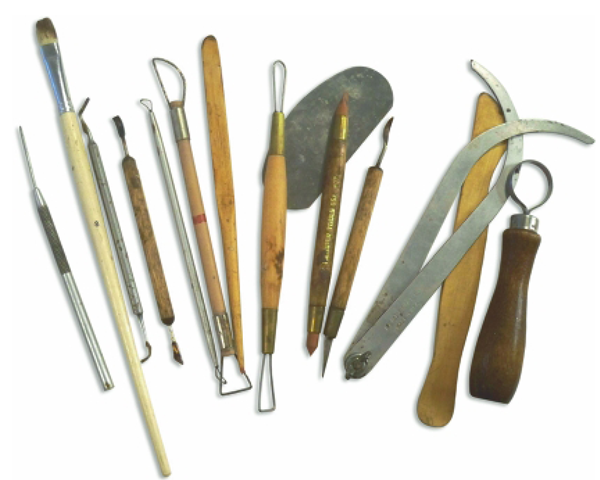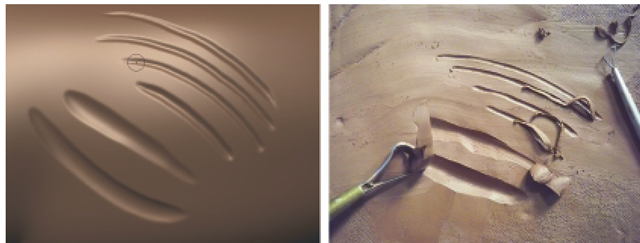From the beginning, we want to draw strong correlations between traditional studio sculpting and digital sculpting in Mudbox as a foundation for the topics that will be covered in this topic and parts of this topic. So, we begin by reviewing traditional sculpting tools and techniques and comparing them with the digital sculpting tools and techniques in Mudbox. Then, we will briefly discuss topics, such as anatomy, form, proportions and measurements, gesture, and emotion and expression, as applied to sculpture.
Workspace
A traditional sculpture studio is a large workspace that affords the sculptor the room to sculpt and to step back and view the sculpture from all sides. When working on a traditional sculpture, the clay is placed on a stand with wheels that can be moved around the subject. Continuous viewing of the sculpture from different angles avoids problems such as having a sculpture end up looking flat. Also sculpting on an individual area and then pulling away to look at the entire subject is an essential routine or, for example, you may have sculpted a perfect ear, but then you find that it is too small for the face. By pulling back and comparing the whole sculpture to the focused area, you will ensure that you are keeping things in proportion and not getting carried away with details too early – an easy thing to do when in a creative flow.
FIG 1.1 When Working with Mudbox, the Program’s interface Provides All the Space and Tools Required for Sculpting.
In Mudbox, the interface becomes the sculpture studio (Figure 1.1). Mudbox’s camera navigation tools are analogous to the sculpture stand and the sculptor moving around in the studio. Navigating within the 3D scene allows the same relative movements of the sculptor to subject and sculpture. With a click, you can zoom out and view all of your work, rotate it to see it from different angles, or zoom in to create fine details.
Armatures
A traditional clay sculpture is created around an armature. The armature supports the clay during sculpting, and it is usually made of wire, wood, or other materials to which the sculptor will add the clay. In Mudbox, the initial polygonal model is analogous to the armature and clay. The polygonal model is composed of polygons (faces), edges, and vertices, and these components, together, build the surface that will be sculpted. The model could either be one of the model templates that are included with Mudbox or a model created in another program and imported into Mudbox.
Lighting
A sculpture studio is equipped with movable lights that allow the sculptor to light the sculpture and subject in different ways to study forms, shadows, and details. Often, the look and feel of a sculpture changes with different lighting. It is said that Rodin would take a candle to his artwork in the dark to see the shadows more clearly. In Mudbox, the lighting is also very important. Using the default light or lighting presets in Mudbox accomplishes the same goals as the real studio lights. In fact, in Mudbox, you can add as many digital lights as you want and move them around as needed.
Sculpting Tools
The tools available in the traditional sculpture studio are numerous.
Wooden modeling tools, metal clean-up tools, rasps, trimming tools, loops, spatulas, and dental tools are used (Figure 1.2). Each tool comes in various sizes and strengths depending on the density of the clay and the size of the project. Kitchen utensils, found objects, and straight pins are all usable. “Whatever works" quickly becomes an indispensable tool. Sponges, paintbrushes, and even nylon stockings are used in conjunction with either water or a solvent, depending on the type of clay, to help to smooth the clay.
Cloth and other found items are useful tools, as they are pressed into the clay to create texture and patterns. Adding textures to a sculpture helps to give contrast to different sections, thereby producing an overall realistic and detailed appearance.
Mudbox has many of the same tools found in the traditional sculpture studio. However, in Mudbox, the tools are named based on their function. So, in Mudbox, you will not find a rasp, mallet, or brush, instead you will find the Scrape, Flatten, and Smooth tools. These tools can be customized by adjusting their properties such as size, strength, and falloff to create a myriad of tools that do different tasks. To create textures such as wrinkles or scales, there is a wide range of stamps and stencils that can be used in combination with the sculpting tools. So, as you can see, for just about every sculpting action found in the real sculpture studio, there is a tool or combination of tools in Mudbox that will create the same or similar effect (Figure 1.3).
Of course, there are differences between working with real clay and polygons, but with practice, those differences soon fade and sculpting in Mudbox becomes second nature. Although sculpting with real clay has its advantages, so does sculpting with Mudbox. For example, in Mudbox, you can use sculpt layers either to organize levels of sculpting details or to simply experiment in a nondestructive manner – something that is impossible with real clay.
FIG 1.2 Traditional Sculpting Tools Come in a Variety of Sizes and Shapes.
FIG 1.3 Mudbox Sculpting Tools Produce the Same or Similar Sculpting Effects as Real Sculpting Tools.
The traditional techniques of adding, blending, smoothing, scraping, pinching and pulling the clay to sculpt and add details vary, depending on the type of clay and size of the sculpture. For example, a small water-based clay sculpture that needs a change in shape may simply be pressed with the thumb, but a large life-size or monumental sculpture may require a rubber mallet. In Mudbox, the actions of the sculpting tools will also vary, depending on the resolution and size of the model. For instance, if you use the Sculpt tool on a mesh that is not sufficiently subdivided, the result will be a coarse and lumpy mess. However, with subdivided mesh, the same tool produces a beautifully sculpted stroke. The size of the mesh also plays an equally important role in how the sculpting tools work. Because Mudbox has an internal scale, sculpting on a small mesh produces different results than sculpting on a larger mesh, assuming all other variables are the same.
Mudbox is a close analogy of real clay sculpting as it provides the sculptor with a digital sculpture studio stocked with all of the sculpting tools and materials needed to produce just about any sculpture. Although Mudbox may not be an exact equivalent to real clay sculpting, the same sculpting techniques and concepts used in traditional sculpting apply when sculpting in Mudbox. In the next section of this topic, you will review basic concepts like anatomy, proportions and measurements, form and gesture, and emotions as applied to sculpture.



